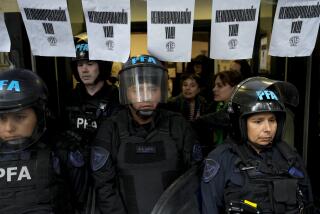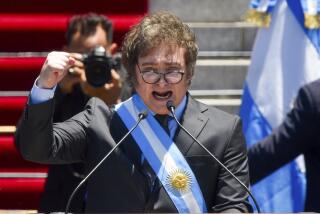Audacious Health Plan : A Medical Revolution in the Andes
- Share via
QUECHUQUINA, Argentina — Eliana Perez, a 32-year-old grandmother who lives in this woodcutter’s village in southern Argentina, has learned her lessons well.
Water? “It must be boiled before drinking,” she recited. Garbage? “It must be burned.” Treatment for children with diarrhea? “Water boiled with rice. Never milk.”
The men putting the questions to Eliana Perez one afternoon recently were Herminio Casanova, who travels this rural area in the name of public health, and Gregorio Quirno Costa, a pediatrician who heads a small public hospital in the town of San Martin de los Andes, about 20 miles by dirt road to the east of here.
House Calls Commonplace
In Argentina, where doctors are abundant, affordable and accessible, the house call is commonplace. Here in the Argentine Andes, doctors make village visits.
Quechuquina is an isolated settlement on the shore of a glacial lake. It lies within Lanin National Park, named after a nearby volcano, and only a few miles from Argentina’s border with Chile. If Quechuquina has any distinction beyond the natural beauty of its surroundings, it is as one of the most remote beneficiaries of a backlands medical revolution.
The settlement--34 families, 286 people--is in the frontier province of Neuquen, where against all odds people are getting healthier because their government insists on it.
An audacious provincial health program, now in its second decade, has survived national economic decline and political convulsion with such success that it is winning international attention.
Third World Example
“When we go to conferences, people ask how we do it,” Quirno Costa said. “The U.N.’s World Health Organization has cited the Neuquen program as an example to a number of Third World countries.”
Conceived by a group of young doctors under populist Gov. Felipe Sapag in the mid-1960s, the Neuquen program is based on successive layers of care at no cost to patients. At the top is a well-equipped hospital in Neuquen city, the provincial capital. Then come zonal hospitals like the one at San Martin, which has 13 doctors and 60 beds. Next are smaller area hospitals with a handful of doctors who specialize in family medicine. At the base of the pyramid are circuit-riding “sanitary agents”--Casanova is one of these--who patrol outlying areas, usually alone, sometimes together with a doctor and dentist from the nearest hospital.
Earlier in January, when Quirno Costa stopped at a wooden shack here to check on 8-month-old Maria Eugenia Saez, who had been brought to the hospital in a severely dehydrated condition, her mother produced a carefully kept family health record that showed this to be the ninth visit to the house since September, 1982.
Doctors Get Around
Dr. Willy Arrue, who directs preventive and clinical visits to Quechuquina and nine other rural settlements from the hospital at San Martin, said, “A doctor’s job is prevention as much as cure. To reach those who most need help, particularly the young, we must leave the hospital.”
Fruits of the Neuquen health scheme are readily apparent, both in statistical and human terms.
“It is a pleasure to teach here,” said Jorge Oscar Nahuelquin, who runs Quechuquina’s picture book two-room school. “These children are alert. They are healthy.”
It was not always so. Neuquen is about the size of Michigan, but even though its population has more than doubled since 1960 it still has only about 250,000 people, about 40% of whom live in Neuquen City, the provincial capital. Overall, population density is only about four people to the square mile. The land here is poor for grazing, yet sheep and cattle ranching is extensive. Neuquen was settled relatively late and was upgraded from territory to province only in 1958. It was for many years a hard-bitten outback.
Infant Mortality Appalling
“What pushed us toward establishing the health program was that the infant mortality statistics were so appalling--the worst in the country,” said Jorge Solana, one of the province’s two senators.
In 1960, infant mortality was 118 per 1,000 births, according to provincial records, nearly twice the national level. Life expectancy, then 47 years, has since risen to 62, and Neuquen’s infant mortality has fallen to a level among the lowest in Latin America. The provincial health secretariat puts it at 27 per 1,000 births for 1983, compared with 32 per 1,000 for Argentina as a whole.
Once under way, the program proved surprisingly immune to the procession of military and civilian governments that ruled Argentina from the mid-1960s until the end of 1983. “Some of them tried to tinker with the program, but they met fierce resistance from the doctors,” Solana said.
Wallops Peronist Candidate
When democracy returned to Argentina, in December, 1983, Sapag was the overwhelming choice for governor. He ran as the candidate of a provincial party rather than one of the national parties--Neuquen is one of only three provinces where provincial parties are in power--and he walloped the candidate of the Peronist Party, the strongest political force in Argentina for 40 years, as well as the candidate of the Radical Civic Union, which won the presidency with Raul Alfonsin.
Some of the doctors who helped build the Neuquen program now work in key public health jobs in the Alfonsin government in Buenos Aires.
The Neuquen program, which employs 2,036 people, including 330 doctors and 37 dentists--together they saw 788,000 patients in 1983--has the reputation of being exceptionally well-administered.
About 8 p.m. on a recent evening, a visitor to the Solana home in San Martin asked Solana how much the health program cost. He shrugged, then went to the phone. He called the provincial minister of social welfare in Neuquen City, who was in his office, who called the subsecretary for public health, who was in his office. Solana’s phone rang five minutes later.
10% of Provincial Budget
“They say about 10% of the provincial budget--about 740 million pesos in 1984,” Solana reported. At the present rate of exchange, that is less than $4 million, but the dollar figure is misleading, for the pesos were spent in the course of a year in which inflation reached nearly 700%.
Clearly, back-country hospitals like the one at San Martin, which has a year-round population of about 14,000, are rudimentary by U.S. standards. But clearly, too, they save lives.
Renouf Russell, who comes down here from New Hampshire every summer to fish the local trout streams, said that when he was here last year he became ill. He said this was 10 months after coronary bypass surgery, and he added:
“They treated me at the hospital and didn’t charge me a dime. When I got back to New England, my doctor asked: ‘Who are those guys down there in the sticks? They made exactly the right diagnosis and prescribed exactly the right treatment.’ ”
Many Doctors Apply
Neuquen recruits its doctors through competitive examination, and there is no shortage of applicants, particularly from among young doctors anxious to escape hectic--and over-doctored--big cities.
Last year, there were 65 applicants for 12 residencies offered by the province. All 13 of the hospital doctors at San Martin and all nine of the town’s private physicians have come to the province from big cities, according to Quirno Costa, who at 48 is the oldest among them.
Nothing could be further from sophisticated Buenos Aires than the Perez family home here. It has a wood-burning stove but no running water or electricity. Yet by the standards of rural Latin America it represents only modest hardship. And, significantly, the people who live here are healthy.
Children All Well
When the visitors came on that recent afternoon, Senora Perez was pleased to say that her nine children and two grandchildren were all well. She, herself, though, was feeling poorly. Quirno Costa examined her, diagnosed a sore throat, prescribed aspirin and went on about his rounds.
“When the program started, a lot of doctors thought there was something communistic about working full-time for the state,” Quirno Costa said. “Now, two or three doctors a week passing through town stop by to say hello and nearly all of them wind up saying how much they’d like to get out of their city practices and come to work here.
“I think a lot of us have come to realize that once basic needs are met, a doctor’s reward is not economic but professional satisfaction.”
The frontier doctors of Neuquen are among Argentina’s highest-paid civil servants. They get a rent-free government house and free utilities, plus a salary of around $800 a month.
More to Read
Sign up for Essential California
The most important California stories and recommendations in your inbox every morning.
You may occasionally receive promotional content from the Los Angeles Times.













